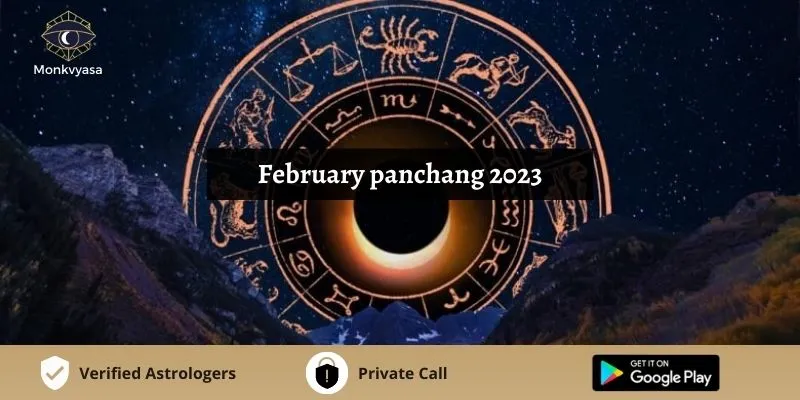

February Panchang 2023
The Monthly Panchang or Panchangam is a Hindu-based monthly calendar used in India. Believing in the significance of auspicious moments, Indians consult the Panchang, or Indian calendar, before starting any new activity. The Panchang follows the traditional 12-month astronomical calendar, also known as an almanac, based on ancient Vedic teachings.
What is Panchang?
The Panchang is a calendar comprised of five components, referred to as "limbs." The name "Panchang" is derived from two Sanskrit words: "Panch," meaning "five," and "Ang," meaning "limbs". These five limbs are Tithi, Vaar, Yog, Karan, and Nakshatra. The Panchang acts as a time-keeping system, similar to a ledger in accounting. It is a Sanskrit term, with "Panchangam" being another name for it. The five limbs of the Panchang are based on the five fundamental parts of Vedic Astrology. Astrologers utilize the Panchang to determine auspicious times for performing various tasks and calculate a person's Vedic birth or natal chart. In different regions of India, it is referred to by various names, such as Tamil Panchangam, Telugu Panchangam, Kannada Panchangam in South India, Gujarati Panchang in Western India, Hindu Panchang in North India, and Bengali Panchang in East India. The Panchang, also known as the Hindu Calendar, is based on the readings of the Nakshatras in the sky.
How is Monthly Panchangam Calculated?
The Monthly Panchang is a table of important dates and times for a specific month. It provides information on auspicious moments by considering astrological and astronomical data, including the position of the Moon Nakshatra. This is significant because the dates in the Panchang are primarily based on the nakshatra of one's natal Moon. The calculations in the Panchang are based on the position and movement of celestial bodies like planets, stars, and Nakshatras in specific signs and degrees. These alignments and their potential effects on individuals on certain dates can be determined through the important dates in the Panchang. To fully comprehend the casting of a Panchang, it's necessary to understand the concept of the sidereal movement of celestial bodies. This requires extensive mathematical calculations, understanding of geometric patterns, and knowledge of astronomical phenomena. The Panchang is used to determine Tithi, Vaar, Yog, Karan, and Nakshatra, ultimately leading to the calculation of Muhurat - an auspicious time for important tasks such as marriage, housewarming ceremonies, and religious ceremonies. The Panchang is particularly effective in using medicinal herbs and Ayurvedic treatments, as starting medication during a specific Nakshatra can result in faster recovery from illnesses. The Ephemeris lists important dates and times of popular Indian festivals for the month based on the positions of the Moon and planets in specific Nakshatras and signs. The Panchang provides accurate timings for performing any task.
Five Limbs of Monthly Panchang
As previously mentioned, the Monthly Panchang in Vedic Astrology is divided into five parts. The calendar consists of 12 months, each further divided into two phases known as Shukla Paksha and Krishna Paksha, each lasting 15 days. The months are calculated based on the movement of the Sun and Moon. The day the Sun enters a specific sign is celebrated as Sankranti, and the position of the Moon in a specific Nakshatra on the full moon day determines the month of the year. Here are the five limbs of the Panchang.
Also Read: 9 Amazing Vastu Tips For Career Growth.
Tithi
In Vedic Astrology, there are 30 this in a month. The first 15 are in Shukla Paksha, and the remaining 15 are in Krishna Paksha. A tithi is determined by the moon completing 12 degrees. The two pakehas are also known as the bright half and dark half of the moon. These are categorized into 5 types: Nanda, Bhadra, Rikta, Jaya, and Poorna.
Vaar
The term 'Vaar' or Day refers to the interval between one sunrise and the next. It represents the 7 days of the week: Sunday, Monday, Tuesday, Wednesday, Thursday, Friday, and Saturday.
Yog
Yog refers to the combination of the longitude of the Sun and the Moon, calculated by dividing the sum by 13 degrees 20 minutes. There are 27 Yogas defined in Vedic Astrology.
Karan
In Vedic Astrology, Karan is calculated as half of a Tithi. So, if a month has 30 Tithis, it will have 60 Karans. There are two types of Karans: Movable and Fixed. Movable Karans are 7 in number (Baav, Balav, Kaulav, Tatilya, Gara, Vaanij, Vishti), and Fixed Karans are 4 in number (Shakuni, Chatuspad, Naag, Kitughna).
Nakshatra
The 27 Nakshatras in Astrology and Astronomy are known as 'Constellations'. Each Nakshatra consists of 4 Charans, and one Zodiac Sign is made up of 9 Charans. The names of the 27 Nakshatras in sequence are: Ashwini, Bharani, Krittika, Rohini, Mrigshira, Ardra, Punarvasu, Pushya, Ashlesha, Magha, Poorva Phalguni, Uttar Phalguni, Hasta, Chitra, Swati, Vishakha, Anuradha, Jyeshtha, Mula, Poorva Ashada, Uttar Ashada, Sravan, Dhanistha, Shatbisha, Poorva Bhadrapad, Uttar Bhadrapad, and Revati.
Name of Months in a Panchang
In Hindu Vedic Astrology, twelve months are derived. All months are determined by the name of a particular Nakshatra. Below is the HIndu Calendar's definition of the Months. Chaitra, Vaisakha, Jyeshtha, Ashadh, Sharavan, Bhadra, Ashwin, Kartik, Margasheersh, Paush, Maagh, Phagun. Need of Panchangam To find the most auspicious month in our lives, we need to monitor monthly panchang. You can have fruitful results if you start a new venture during a bright star. These are some of the tasks you can use it for:
- Panchang is important for checking your daily or practical tasks based on astrology.
- It's a time-finding tool that can be used to determine the best time to start a business.
- This astrological diary helps you know the positions of planets or nakshatras within a sign.
- This ancient science helps you determine the best time to begin any activity to increase your chances of success.




 Call Now !
Call Now !



